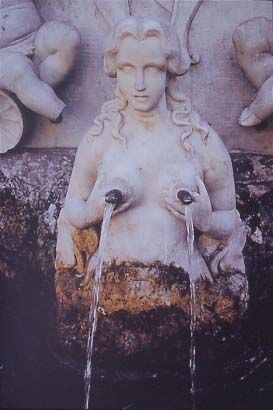Nan Goldin
Since the age of eighteen, Nan Goldin has used photography as a visual diary of her life and of the extended family of friends and lovers with whom she shares her experiences. The artist has said that she considers the camera an “extension of her arm,” alluding to the total continuity between her art and the intensity of her life. Photographs taken in the early 1970s, in Boston, emerge from the artist’s fascination with drag queens, the friends with whom she was living during that period. Goldin’s subsequent move to color photography further emphasizes her work’s connection to her own experience. Images of her years spent in New York feature night time interiors. Alcohol, drugs, and sex figure prominently in these scenes, but Goldin also created some photographs of a disarming domestic nature at this time. The artist has exhibited her work as slide shows, which she often updates. These are accompanied by a soundtrack she assembles, using songs from 1950s and 60s.
“I thought that I wouldn’t lose anyone, if only I photographed them enough,” the artist has said, about the close relationship between her photography and the desire to use it as a means to preserve the memory of people she has loved. The violent outbreak of AIDS, which overtook many of the anti-heroic figures in her images, sharpened the sense of loss that characterizes all Goldin’s work. Gilles and Gotscho Embracing, Paris, 1992, and Gilles Arm, Paris, 1993, belong to a group of photographs related to the final months in the life of Gilles Dusein, who at the time was Goldin’s art dealer in Paris. In the first image Gilles appears with his companion in a pose that seems to tie the two heads and chests into an indissoluble knot, formally not dissimilar to the symbol for infinity. In Gilles Arm, taken soon after the first image, Goldin’s empathy leads her to photograph the sick man’s arm like that of a martyr, whose body is now made up of ravaged parts.
In the 1990s she discovered a renewed love of life in photographing children, including those of her friends, and she also began to work outdoors and create landscape images. A group of landscape photographs from this time taken in Naples, home to some of friends, is in the collection of the Castello di Rivoli. These images feature light and color, especially various shades of blue, the color of the Mediterranean and of melancholy. In addition to portraying new friends, as in Pavel Topless, Naples, 1996, the artist was moved to investigate the traces of lost companions. In Junkie Madonna, Forcella, 1996, she photographed the small piazza behind the train station, a common location for drug dealing. In the photograph the piazza becomes above all a tranquil spot, illuminated by the bluish presence of a statue of the Madonna. Statue with Flowing Breasts, Amalfi, 1996, emphasizes, instead, the erotic fullness of a characteristic fountain located near the Amalfi cathedral.
[MB]



